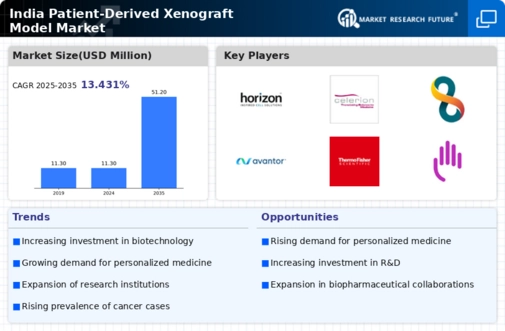Increasing Research Funding
The patient derived-xenograft-model market in India is experiencing a surge in research funding from both governmental and private sectors. This influx of financial resources is likely to enhance the development of innovative cancer therapies and personalized medicine approaches. In 2025, the Indian government allocated approximately $1.5 billion to cancer research initiatives, which is expected to bolster the capabilities of research institutions and biotechnology firms. As a result, the patient derived-xenograft-model market is poised for growth, as these models are essential for preclinical testing and understanding tumor biology. The increased funding may also facilitate collaborations between academic institutions and industry players, further driving advancements in this market.
Collaborative Research Initiatives
Collaborative research initiatives between academic institutions and industry players are becoming more prevalent in India, which is likely to benefit the patient derived-xenograft-model market. These partnerships facilitate the sharing of resources, expertise, and data, leading to accelerated advancements in cancer research. For instance, several universities have established partnerships with biotechnology firms to develop innovative cancer therapies using patient derived-xenograft models. Such collaborations not only enhance the quality of research but also increase the visibility and application of these models in clinical settings. As these initiatives continue to grow, the patient derived-xenograft-model market is expected to expand accordingly.
Rising Awareness of Cancer Research
There is a notable increase in awareness regarding cancer research and its significance in India, which is positively impacting the patient derived-xenograft-model market. Educational campaigns and initiatives by non-profit organizations and healthcare institutions are fostering a better understanding of cancer biology and treatment options among the general public. This heightened awareness is likely to lead to increased participation in clinical trials and research studies, thereby driving demand for patient derived-xenograft models. As more patients become informed about their treatment options, the market may see a rise in the utilization of these models for developing targeted therapies.
Expansion of Biopharmaceutical Sector
The biopharmaceutical sector in India is expanding rapidly, which is likely to have a favorable impact on the patient derived-xenograft-model market. With the increasing number of biopharmaceutical companies focusing on oncology, there is a growing need for reliable preclinical models to test new drug candidates. The biopharmaceutical market in India is projected to reach $100 billion by 2025, indicating a robust growth trajectory. This expansion is expected to drive investments in research and development, thereby increasing the demand for patient derived-xenograft models as essential tools for drug discovery and development.
Growing Demand for Personalized Medicine
There is a growing demand for personalized medicine in India. As healthcare providers increasingly recognize the importance of tailoring treatments to individual patients, the need for effective preclinical models becomes paramount. Patient derived-xenograft models allow researchers to study the unique characteristics of tumors from individual patients, leading to more effective treatment strategies. This trend is supported by a report indicating that the personalized medicine market in India is projected to reach $10 billion by 2026, reflecting a compound annual growth rate (CAGR) of 12%. Consequently, This market is likely to benefit from this shift towards personalized healthcare solutions.




















Leave a Comment